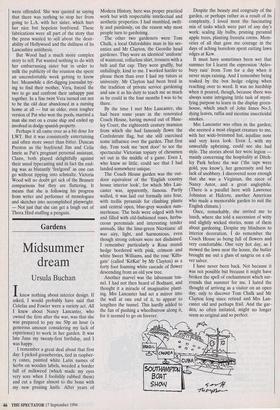Gardens
Midsummer dream
Ursula Buchan
Iknew nothing about interior design. If asked, I would probably have said that Colefax and Fowler were a variety act. All I knew about Nancy Lancaster, who owned the firm after the war, was that she was prepared to pay me 50p an hour (a generous amount considering my lack of experience) to work in her garden. It was late June my twenty-first birthday, and I was happy.
I remember a great deal about that first day: I picked gooseberries, tied in raspber- ry canes, painted white Latin names of herbs on wooden labels, weeded a border full of milkweed (which made my eyes very sore when I foolishly rubbed them) and cut a finger almost to the bone with my new pruning knife. After years of Modern History, here was proper practical work but with respectable intellectual and aesthetic properties. I had stumbled, swift- ly and painlessly, on the reason why most people turn to gardening.
The other two gardeners were Tom Chalk, a local Oxfordshire man in his sev- enties and Mr Clayton, the Geordie head gardener. They wore an identical 'uniform' of waistcoat, collarless shirt, trousers with a belt and flat cap. They were gruffly, but unfailingly, kind to me. I worked harder to please them than ever I had my tutors at university. Mr Clayton had been bred in the tradition of private service gardening and saw it as his duty to teach me as much as he could in the four months I was to be there.
By the time I met Mrs Lancaster, she had been some years in the renovated Coach House, having moved out of Hase- ley Court, the eighteenth century mansion from which she had famously flown the Confederate flag, but she still exercised some influence over the garden. That first day, Tom took me 'next door' to see the spectacular Victorian topiary of chessmen set out in the middle of a game. Even I, who knew so little, could see that I had landed somewhere unique.
The Coach House garden was the out- door equivalent of the 'English country house interior look', for which Mrs Lan- caster was, apparently, famous. Partly walled, it was laid out formally into four, with trellis pyramids for climbing plants and central open, blue-grey wooden sum- merhouse. The beds were edged with box and filled with old-fashioned roses, herba- ceous perennials and interesting tender annuals, like the lime-green Nicotiana: all was airy, light, and harmonious, even though strong colours were not disdained. I remember particularly a Rosa mundi hedge bordered with pink, crimson and white Sweet Williams, and the rose `Kifts- gate' (called `KitKat' by Mr Clayton) as a forty foot foaming white cascade of flower descending from an old yew tree.
Another marvel was the laburnum tun- nel. I had not then heard of Bodnant, and thought it a miracle of imaginative plant- ing. Mrs Lancaster had set a mirror into the wall at one end of it, to appear to lengthen the tunnel. This hardly added to the fun of pushing a wheelbarrow along it, for it seemed to go on forever. Despite the beauty and congruity of the garden, or perhaps rather as a result of its complexity, I loved most the fascinating mix of tasks which were part of any day's work: scaling lily bulbs, pruning pyramid apple trees, planting freeszia corms. Mem- ories of all that gave me courage in the days of aching boredom spent cutting lawn edges at Kew.
It must have sometimes been wet that summer for I learnt the expression 'Ayles- bury rain' from Tom for a day when it never stops raining. And I remember being soaked by the box hedge edging when reaching over to weed. It was no hardship when it poured, though, because there was always some intriguing little task of mysti- fying purpose to learn in the display green- house, which smelt of John Innes No.3, dying leaves, raffia and nicotine insecticidal smokes.
Mrs Lancaster was often in the garden; she seemed a most elegant creature to me, with her wide-brimmed hat, aquiline nose and very keen look. Even I, with my unworldly upbrining, could see she had style. The stories about her were legion mainly concerning the hospitality at Ditch- ley Park before the war (the taps were gold, you know'), her generosity and her lack of snobbery. I discovered soon enough that she was a Virginian, the niece of Nancy Astor, and a great anglophile. (There is a parallel here with Lawrence Johnston at Hidcote, another American who made a memorable garden to suit the English climate.) Once, remarkably, she invited me to lunch, where she told a succession of witty and slightly wicked stories, none of them about gardening. Despite my blindness to interior decoration, I do remember the Coach House as being full of flowers and very comfortable. One very hot day, as I mowed the lawn near the house, the butler brought me out a glass of sangria on a sil- ver salver.
I have never been back. Not because it was not possible but because it might have broken the spell of enchantment which sur- rounds that summer for me. I hated the thought of arriving as a visitor on an open day, only to discover Tom Chalk and Mr Clayton long since retired and Mrs Lan- caster old and perhaps frail. And the gar- den, so often imitated, might no longer seem so original and so perfect.


























































 Previous page
Previous page